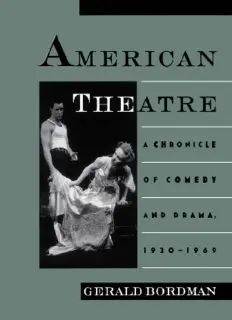
American Theatre: A Chronicle of Comedy and Drama, 1930-1969 (American Theatre : a Chronicle of Comedy and Drama) PDF
Preview American Theatre: A Chronicle of Comedy and Drama, 1930-1969 (American Theatre : a Chronicle of Comedy and Drama)
AMERICAN THEATRE: A Chronicle of Comedy and Drama, 1930-1969 This page intentionally left blank AMERICAN THEATRE: A Chronicle of Comedy and Drama, 1930-1969 GERALD BORDMAN New York Oxford OXFORD UNIVERSITY PRESS 1996 Oxford University Press Oxford New York Athens Auckland Bangkok Bobota Bombay Buenos Aires Calcutta Cape Town Dar es Salaam Delhi Florence Hong Kong Istanbul Karachi Kuala Lumpur Madras Madrid Melbourne Mexico City Nairobi Paris Singapore Taipei Tokyo Toronto and associated companies in Berlin Ibadan Copyright © 1996 by Gerald M. Bordman Published by Oxford University Press, Inc., 198 Madison Avenue, New York, New York 10016 Oxford is a registered trademark of Oxford University Press All rights reserved. No part of this publication may be reproduced, stored in a retrieval system, or transmitted, in any form or by any means, electronic, mechanical, photocopying, recording, or otherwise, without the prior permission of Oxford University Press. Library of Congress Cataloging-in-Publication Data Bordman, Gerald Martin. American theatre : a chronicle of comedy and drama, 1930-1969 Gerald Bordman. p. cm. Includes index. ISBN 0-19-509079-9 1. Theater—United States—History—20th century. 2. American drama—20th century—Stories, plots, etc. I. Title. PN2266.B64 1996 792'.0973'0904—dc20 96-17572 1 3 5 7 9 8 6 42 Printed in the United States of America on acid-free paper PREFACE This is the third volume in our series American Theatre: A Chronicle of Comedy and Drama. The first volume examined the seasons from 1869-70 through 1913-14, when, for the most part, the legitimate theatre remained the nation's primary entertainment milieu; the second, the halcyon theatri- cal years from 1914–15 through 1929-30. Since this volume deals with the seasons from 1930-31 through 1968-69, the three-work set covers what are assuredly the hundred most exciting years of American playwriting and playgoing. In the early years surveyed here, "Broadway," that tiny, playhouse-packed enclave in mid-Manhat- tan, represented virtually all there was of real, enduring interest to theatre lovers. The shrinking road was confined almost wholly to tryouts and post-Broadway tours. But after World War II, what became known as "Off Broadway," which had bloomed tentatively in the 1920s, resurged and in a short while became a major factor. Considerations of space and time have precluded our examining it with the thoroughness with which we have looked at regular Broadway mountings, but we have tried to include many of the longer-run off-Broadway hits. Indeed, by the time we reach the end of this volume, much of the freshest, most interesting writing was coming from there. It should be noted, too, that the same considerations of space and time have permitted us to look at only the main Federal Theatre offerings in Manhattan. Mountings by its Children's Theatre, its peripatetic Suitcase Unit, and some straightforward Harlem revivals have been ignored, as have a number of productions away from New York. Once again, a few caveats. Programs were sometimes careless in spelling names, and, sometimes, people changed the spelling of their names. We have attempted to adopt a uniform spelling through- out, although a few instances may have slipped by us, and we have made a handful of exceptions. Some critics wondered aloud why Charlotte Armstrong shortened her name to the harsher Charl. We have kept her name as they were in the programs. So long as Bus-Fekete's works were presented in translation his name was spelled one way, but after he apparently began to write directly in English (was he a refugee?) an "h" was added. We have added it accordingly. When actors have dropped the "Jr." from their names, we have quietly dropped it, too. Other spellings, punctuation, and capitaliza- tion in quotations have been brought in line with accepted modern practice by our copy editor. Special thanks must be extended to the excellent staff at the library of Millersville University, notably Ray Hacker, Leo Shelley, and Donald Tribit, as well as to John Schenke, who helped there with photocopying; to Geraldine Duclow and Elaine Ebo at the Theatre Collection of the Free Library of Philadelphia; to Robert Taylor at Lincoln Center's Library of the Performing Arts; to Ray Wem- mlinger of the Hampden-Booth Library; to the distinguished theatrical historians Ian Bevan and Kurt Ganzl; to Jacques Kelly and to Richard Norton. Of course, my heartfelt thanks go to my friends and colleagues at Oxford University Press: India Cooper, Joellyn Ausanka, Leona Capeless, and to my incomparable, always understanding editor, Sheldon Meyer. Kirk's Mills, Pa. Gerald Bordman June 1996 This page intentionally left blank Act One, 1930–1944 The Waning of the Golden Age 1930–1931, 3 1931–1932, 29 1932–1933, 57 1933–1934, 81 1934–1935, 100 1935–1936, 119 1936–1937, 138 1937–1938, 155 1938–1939, 169 1939–1940, 181 1940–1941, 193 1941–1942, 204 1942–1943, 214 1943–1944, 224 Act Two, 1944–1959 A Silver Age? 1944–1945, 237 1945–1946, 249 1946–1947, 258 1947–1948, 266 1948–1949, 275 1949–1950, 284 1950–1951, 290 1951–1952, 300 1952–1953, 308 1953–1954, 315 1954–1955, 322 1955–1956, 330 1956–1957, 338 1957–1958, 345 1958–1959, 353 Act Three, 1959-1969 Decline 1959–1960, 363 1960–1961, 370 1961–1962, 376 1962–1963, 382 1963–1964, 389 1964–1965, 397 1965–1966, 402 1966–1967, 410 1967–1968, 417 1968–1969, 426 Index, 435 ACT ONE 1930-1944 THE WANING OF THE GOLDEN AGE
